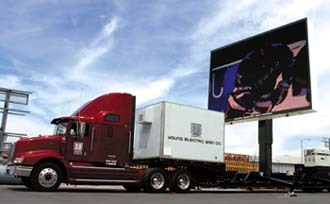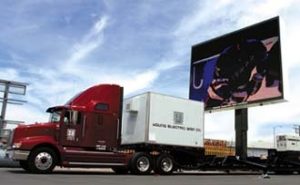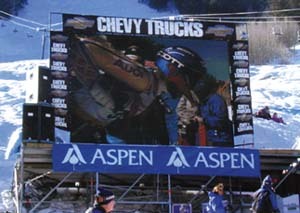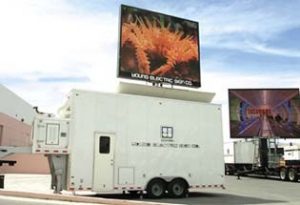Large-format LED video displays — billboards, stadium scoreboards and roadside pylons — have become urban fixtures, as in Times Square and Las Vegas, where huge LED video billboards enhance promotions and advertising with high-resolution images and an impressive palette of up to 16.7 million colors.
However, a secondary market of temporary, independent locations has added two new attributes to videoboards — mobility and portability. If Mohammed can’t come to the mountain, then the mountain must come to Mohammed.
Moving on
Although mobile LED signs have been used for many years, Las Vegas-based Young Electric Sign Co. (YESCO) has significantly improved the design and delivery of mobile units. In 1999, YESCO built its first mobile LED. Today, the company has established a fleet of trucks and a partnership with Mobile View (Englewood, CO) to place LED billboards at sporting events, political rallies and other special venues.
YESCO Electronics Sales Manager Neil Whitaker says, LED billboard trucks offer clients at least two media resources: replay of pre-recorded advertising and the ability to do on-site, live coverage of an event. Typically, clients use screens for live coverage, but we’re seeing an increased use in pre-recorded ads to provide enhanced advertisement for event sponsors.”
Creating a mobile sign is simple: Attach an LED billboard to a truck, and take it to the customer. To do so, YESCO builds a series of LED subsections as display tiles, assembles them as a screen, and then places them on trucks with portable generators. The truck’s small control center manages the sign’s output, be it a pre-recorded looping advertisement, a live feed from an on-site camera or satellite broadcast downloaded as display content.
Mobile models
YESCO has developed three mobile screen sizes for its LED billboard fleet. Each video-display truck has unique features. A protective shell surrounds the smallest, 11 x 14-ft. T-series screen. Once the unit’s truck is parked, the screen rises out of the truck’s roof and positions itself in minutes.
If several billboard presentation sites must be serviced by the screen, it’s very easy to lower the screen, move the truck, raise the screen and turn it on again.
The S-series, a 16 x 22-ft. unit, assembles with several hydraulic lifts. First, it attaches both screens together as a complete seamless display. Then the screen rises 30 ft. and swivels 360° around its lifting boom. This way, it can be angled in any direction to allow set-up in tight spots to accommodate viewers. The S-series can be assembled in a couple of hours, which is relatively quick for its display size.
The third truck model, the G-series, hosts an 18 x 28-ft. screen that’s assembled in the same format as the S-series, but, as yet, can’t be rotated. Depending on the situation, the G-series also provides audio for promotions or live coverage. The display screen’s perimeter spaces allow banners that advertise event sponsors to be positioned around the video screens.
YESCO’s mobile vehicle partner, Mobile View, also provides state-of-the-art, mobile, electronic, outdoor signage. Mobile View co-owner Darrell Avey sees LED video billboards as a “fan-enhancement” tool useful for large, public, outdoor events.
“There’s no doubt people are attracted to these display screens,” he says. “We’ve done music concerts where large screens are set on the side of the central stage, and people sit by the screens instead of facing stage center.”
Partners John Sweeney and Avey collaborate with YESCO to keep their combined fleets on the road as often as possible.
“We share bookings and the video trucks,” says Whitaker. “When you’ve got a truck fleet available, you want to keep it rented at all times.”
Trucks are assigned to events according to the nature of the assignment and audience. Sweeney notes, “We take great pride in making sure the appropriate screen is made available for each type of event. Placement depends not only on a customer’s budget, but also on the location — where the mobile screen will be placed and how well the audience can view it.”
Aided by good camera work and production support with a video mixer, large screens enhance live coverage by supplementing such special visual effects as instant replays and a larger-than-life display. According to Avey, “Audiences now depend on these screens as an expected part of their outdoor entertainment or sports experience.”
Maximizing mobile marquees
Media-savvy clients see mobile screens as an additional advertising opportunity, almost akin to direct-mail advertising, that provides a targeted audience. Avey says customers often ask him how to maximize mobile screens’ use.
“In many instances,” he explains, “we recommend the appropriate mix of advertising and live coverage. Also, our on-screen, computer-graphics capability allows us to custom design messages for them.”
He also advises clients to carefully position the screen for not only maximum viewing, but also for such ancillary advantages as setting up concession stands so people standing in line can always see the screen.
“This way, people will hang around the screen to watch, and you might get repeat beverage sales,” Avey surmises.
Sweeney outlines other uses. “We’ve done everything from an afternoon football game to a three-week state fair,” he notes. “In the case of a football game, our screen is set up in the stadium parking lot to support a pre-game tailgate party. Usually, the tailgate event is sponsored by a client, so our screen is part of the party. We’ll show the client’s messages and part of the opening of the game.”
At a state fair, mobile screens serve as event marquees, set up as scheduling boards for upcoming shows and judging contests. Other mobile screen appearances have included events covered by ESPN and Fox SportsNet, a track and field meet in Canada, and the 2002 Winter Olympics in Utah.
Regarding client reactions, Whitaker says, “Our best feedback is very simple — we get lots of repeat bookings. In fact, the demand for the trucks has been steady enough that YESCO is looking into building another truck to add to the fleet.”


 Tip Sheet1 week ago
Tip Sheet1 week ago
 Ask Signs of the Times3 days ago
Ask Signs of the Times3 days ago
 Photo Gallery1 day ago
Photo Gallery1 day ago
 Real Deal1 week ago
Real Deal1 week ago
 Benchmarks6 days ago
Benchmarks6 days ago
 Editor's Note2 weeks ago
Editor's Note2 weeks ago
 Women in Signs1 week ago
Women in Signs1 week ago
 Photo Gallery1 week ago
Photo Gallery1 week ago


















